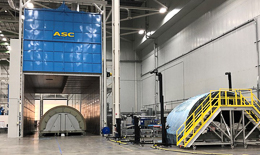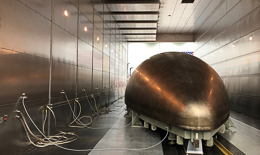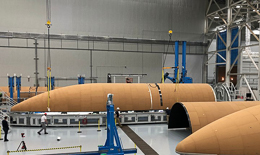SEARCH SITE
"Out of Autoclave" A new direction for composites
With a drive to reduce composite production costs, the aerospace and materials industries have jointly developed composite materials and processes to allow autoclaved parts to be cured in lower-cost ovens. In hundreds of companies, efforts are underway to transition parts toward "out of autoclave" processing. As a major autoclave provider, ASC sees this trend continuing and, rather than buck the trend, we are embracing it.
We bring autoclave technology to composite curing ovens
ASC autoclaves cure billions of dollars worth of aerospace parts each year. Each one of these parts is required to be cured to an exacting process specification, and our customers demand that the autoclave control system collect, analyze, and report on the data for every part.
As autoclaved parts transition to composite curing ovens, our customers are now looking for the same level of quality, control, and data collection as they have become reliant upon in their autoclave operations. Unfortunately, the "old-school" oven industry has never kept up with the technological advances that have driven the autoclave industry. The result is antiquated process control that cannot meet future composite needs.
Fortunately, ASC has the processing knowledge, the know-how, and the technology required to bring autoclave quality, control, and data collection to oven processing.
We can help you transition from autoclave to composite curing oven
For customers who are looking at transitioning from autoclave to "out of autoclave" processing, ASC can provide consulting, engineering, and design analysis to ensure that your parts and tooling will cure properly in an oven. By using state-of-the-art CFD (Computational Fluid Dynamics) software, our engineers can simulate how your tooling will heat in specific oven configurations. With the results of that data, we can then recommend specific oven configurations and capabilities to ensure problem-free processing.
Large structure curing in conventional composite curing ovens
Although "out-of-autoclave" processes for small, secondary structures have been very successful, only recently have aerospace customers tried to bring "out of autoclave" processing to large primary structures.
These large composite structures have historically been cured in autoclaves. The curing of these structures involves massive Invar or aluminum tooling, and as some tools can weigh 100,000 lbs (45,000 kg) or more, the autoclave is able to heat the load at the prescribed rates due to the increased heat transfer effect of pressurized nitrogen media.
Unfortunately, customers who want to transition these primary structures to an oven are left with a very big problem. Because the oven operates at atmospheric pressure, it is far less capable than an autoclave at transferring thermal energy into tools and parts. Actually, due to air density changes, an autoclave at 100 psi (6.9 bar) provides 7-times the thermal transfer coefficient as a conventional oven. As a result of the low thermal transfer, the large primary structures will, in most cases, fail to meet minimum heat rates.
*Images above are courtesy of composite world magazine.










 AUSTRIA
AUSTRIA BRAZIL
BRAZIL CHINA
CHINA FRANCE
FRANCE GERMANY
GERMANY ITALY
ITALY JAPAN
JAPAN LATIN AMERICA
LATIN AMERICA RUSSIA
RUSSIA SOUTH KOREA
SOUTH KOREA SPAIN
SPAIN UK
UK USA
USA